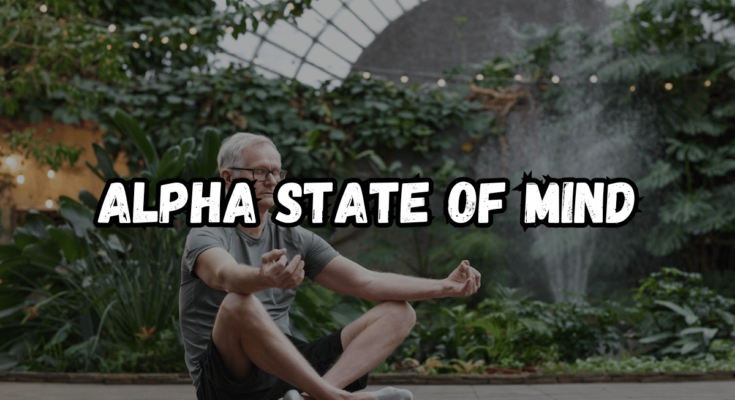Achieving an alpha state of mind, often associated with deep relaxation and focus, can be approached through techniques like deep breathing, meditation, or progressive muscle relaxation. Find a quiet space, sit or lie down comfortably, and focus on your breath or a calming image. Experiment with different methods to see what works best for you. Consistency is key for developing this state of mind.
What are different methods to get alpha state ?
Deep Breathing: Practice slow, deep breaths, focusing on each inhalation and exhalation. This helps calm the nervous system.
Meditation: Regular meditation, especially mindfulness meditation, can promote the alpha state. Focus on your breath, a mantra, or a calming image.
Progressive Muscle Relaxation (PMR): Tense and then gradually release each muscle group in your body, starting from your toes and working your way up. This helps release physical tension.
Visualization: Imagine a peaceful scene or a place where you feel relaxed. Engage your senses in this mental image to enhance the calming effect.
Biofeedback: Use devices that provide real-time feedback on physiological indicators like heart rate or muscle tension. This can help you learn to control these processes consciously.
Binaural Beats or Brainwave Entrainment: Listen to audio tracks designed to synchronize brainwaves to specific frequencies, such as alpha frequencies, to induce a relaxed state.
Guided Imagery: Listen to recordings or follow scripts that guide you through relaxing scenarios, helping your mind shift into a more serene state.
Yoga: Certain yoga practices, such as restorative or yin yoga, can facilitate relaxation and a transition into an alpha state.
Experiment with these methods to discover what resonates best with you, and remember that consistency in practice is key to experiencing the benefits of the alpha state.
Achieving an alpha state of mind, often associated with deep relaxation and focus, can be approached through techniques like deep breathing, meditation, or progressive muscle relaxation. Find a quiet space, sit or lie down comfortably, and focus on your breath or a calming image. Experiment with different methods to see what works best for you. Consistency is key for developing this state of mind.
User
What are different methods to get alpha state?
Deep Breathing: Practice slow, deep breaths, focusing on each inhalation and exhalation. This helps calm the nervous system.
Meditation: Regular meditation, especially mindfulness meditation, can promote the alpha state. Focus on your breath, a mantra, or a calming image.
Progressive Muscle Relaxation (PMR): Tense and then gradually release each muscle group in your body, starting from your toes and working your way up. This helps release physical tension.
Visualization: Imagine a peaceful scene or a place where you feel relaxed. Engage your senses in this mental image to enhance the calming effect.
Biofeedback: Use devices that provide real-time feedback on physiological indicators like heart rate or muscle tension. This can help you learn to control these processes consciously.
Binaural Beats or Brainwave Entrainment: Listen to audio tracks designed to synchronize brainwaves to specific frequencies, such as alpha frequencies, to induce a relaxed state.
Guided Imagery: Listen to recordings or follow scripts that guide you through relaxing scenarios, helping your mind shift into a more serene state.
Yoga: Certain yoga practices, such as restorative or yin yoga, can facilitate relaxation and a transition into an alpha state.
Experiment with these methods to discover what resonates best with you, and remember that consistency in practice is key to experiencing the benefits of the alpha state.
Setting the Scene:
Find a quiet and comfortable space where you won’t be disturbed. Sit or lie down in a relaxed position. You can use a cushion, chair, or yoga mat for comfort.
Posture:
Sit with your back straight and shoulders relaxed. You can cross your legs or sit in a chair with your feet flat on the ground. Rest your hands on your lap or knees.
Focus on the Breath:
Bring your attention to your breath. Notice the sensation of each inhalation and exhalation. You can focus on the rise and fall of your chest or the feeling of air passing through your nostrils.
Mindfulness Meditation:
Practice mindfulness by observing thoughts and sensations without judgment. When your mind wanders, gently bring your focus back to the breath.
Guided Meditation:
Use guided meditation recordings or apps. These often involve a narrator leading you through visualizations, relaxation techniques, or mindfulness exercises.
Mantra Meditation:
Repeat a word, phrase, or mantra silently or aloud. This repetition helps anchor your focus and can have a calming effect.
Body Scan Meditation:
Pay attention to each part of your body, starting from your toes and moving up to your head. Notice any tension or sensations without trying to change them.
Loving-Kindness Meditation (Metta):
Cultivate feelings of love and compassion. Focus on sending positive thoughts and wishes to yourself and others.
Transcendental Meditation
Involves silently repeating a mantra for 15–20 minutes, twice a day. The goal is to reach a unique state of restful alertness.
Zen Meditation (Zazen):
Sit in a specific meditation posture, focusing on your breath and observing thoughts without attachment. Emphasis is often on the experience of “just sitting.”
Chakra Meditation:
Systematically tense and then release different muscle groups, promoting physical and mental relaxation.
Progressive Relaxation:
Focus on energy centers within the body (chakras) to promote balance and well-being.
Frequency and Consistency:
Meditate for a duration that suits your schedule, whether it’s 5 minutes or longer. Consistent practice is more important than duration.
Meditation is a personal journey, and it may take time to find the technique that resonates with you. Regular practice can lead to various benefits, including stress reduction, improved focus, and a greater sense of well-being
The concept of energy centers within the human body is often associated with various spiritual and esoteric traditions. These energy centers are called “chakras” in many Eastern philosophies, particularly in Hinduism and Buddhism. Here’s a brief overview of the seven main chakras:
Root Chakra (Muladhara):
Located at the base of the spine.
Associated with feelings of grounding, stability, and survival instincts.
Sacral Chakra (Svadhisthana):
Located in the lower abdomen, below the navel.
Associated with creativity, passion, and sexual energy.
Solar Plexus Chakra (Manipuri):
Located in the upper abdomen, near the stomach.
Associated with personal power, confidence, and self-esteem.
Heart Chakra (Anahita):
Located in the center of the chest.
Associated with love, compassion, and emotional balance.
Throat Chakra (Vishuddha):
Located in the throat.
Associated with communication, self-expression, and truth.
Third Eye Chakra (Ajna):
Located in the forehead, between the eyebrows.
Associated with intuition, insight, and spiritual awareness.
Crown Chakra (Sahasrara):
Located at the top of the head.
Associated with higher consciousness, spiritual connection, and enlightenment.
In these traditions, it’s believed that each chakra is associated with specific qualities, colors, elements, and sounds. The balanced flow of energy through these chakras is thought to contribute to overall well-being, while blockages or imbalances may lead to physical or mental health issues.
It’s important to note that the concept of chakras is not scientifically proven, and interpretations can vary among different belief systems. Some people find value in practices such as meditation or yoga that incorporate attention to the chakras, while others approach these concepts from a more symbolic or metaphorical perspective.


